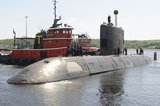DGA receives amphibious landing craft
The French defence procurement agency (DGA) has announced that it has taken delivery of the first fast amphibious landing craft (Engin de Débarquement Amphibie Rapide, or EDA-R). The vessel is the first of four to be delivered under a contract signed in 2009 with engineering company CNIM.
The EDA-R will be operated by the French navy’s Mistral-class Bâtiments de Projection et de Commandement (BPC) amphibious warfare ships. According to the DGA, the vessel has five times the landing capacity provided by conventional landing craft presently in service.
EDA-R is a catamaran-hulled vessel during the fast transit phase, but turns into a flat-bottomed vessel for beaching and for entering the well-deck of its mother ships thanks to its central elevating platform. Each BPC ship can carry two EDA-Rs in its well deck.
Based on the Landing Catamaran (L-CAT) concept developed and patented by CNIM, the vessel was developed to land troops and heavy vehicles from ships remaining at beyond-the-horizon distances (over 30 nautical miles, or 55 km) from shore, and will also be suitable for humanitarian missions in areas that have no berthing facilities.
At 30 meters long and 12 meters wide, the EDA-R has a payload of 80 metric tonnes and top speeds of 18 knots at full load or 30 knots empty. Its forward and access ramps simplify loading and unloading of vehicles.
According to the DGA the three other vessels will be delivered by mid-2012.
More from Naval Warfare
-
![Maritime defence in the Mediterranean faces challenges from vulnerable land power]()
Maritime defence in the Mediterranean faces challenges from vulnerable land power
As an indispensable energy crossroads, the Mediterranean is at serious risk from grey zone disruption. As navies increasingly employ AI data centres, what happens when cutting-edge defence technologies rely on the very infrastructure most susceptible to hybrid tactics?
-
![US Navy to conduct an experimentation campaign with emerging tech in 2026 and 2027]()
US Navy to conduct an experimentation campaign with emerging tech in 2026 and 2027
The Technology Operational Experimentation Events will inform future requirements as the US Navy looks for innovative solutions across three key operational domains.
-
![Future Canadian Continental Defence Corvette will provide “Halifax-equivalent capabilities”]()
Future Canadian Continental Defence Corvette will provide “Halifax-equivalent capabilities”
Although the CDC project is still in its early stages, the Canadian Department of National Defence already has some requirements for the future platforms.
-
![US Navy to acquire micro-uncrewed underwater vehicles for ISR and coastal data collection]()
US Navy to acquire micro-uncrewed underwater vehicles for ISR and coastal data collection
The Naval Supply Systems Command is seeking authorised resellers of JaiaBot uncrewed underwater vehicles and multivehicle pods. The platforms will support undergraduate education at the US Naval Academy.






















